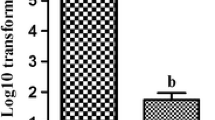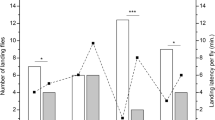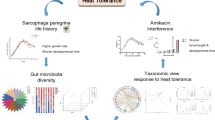Abstract
Endosymbiotic microbiota are known to have an enormous impact on their host, influencing its physiology, behavior, fitness, and various other aspects. The present study hypothesizes that certain bacterial symbionts aid the Oriental fruit fly, Bactrocera dorsalis in its adaptation to survive thermal stress encountered in the environment. Investigative studies on the change in gut and reproductive tract microbiota diversity of male and female B. dorsalis revealed that certain genera of Acinetobacter, Brevibacillus, Bacillus, Enterobacter, Enterococcus, Pseudomonas, and Staphylococcus were involved in the adaptation of B. dorsalis to temperature stresses. The intestinal and reproductive tract bacterial community of B. dorsalis varied depending on the temperature the insects were reared at. We hypothesized that the microbiota present in B. dorsalis’ gut helped it endure temperature stresses over prolonged periods. Out of 54 bacterial isolates, 25, 15, and 14 isolates were obtained from flies reared at 27 °C, 18 °C, and 35 °C, respectively. A 16S rDNA analysis revealed that the bacterial isolates (reared at different temperatures) belonged to different genera. The flies were supplemented with antibiotics to suppress the existing gut microbiota and subsequently fed with bacterial isolates from flies reared at 18 °C, 27 °C (control) or 35 °C separately. When these flies were placed in incubators pre-set at the above temperatures, the survival rate exhibited by the flies differed significantly. The flies fed with bacterial isolates from 18 °C could survive only in incubators pre-set at 18 °C, while flies fed with bacterial isolates from 35 °C could survive only at 35 °C and not vice versa. The microbiota supplementation assay established that the presence of specific bacterial isolates aided the flies’ survival under varied thermal stresses.





Similar content being viewed by others

References
Qi S, Zhou X, Zhang Y (2013) Symbiont-mediated functions in insect hosts. Commun Integr Biol 6:e23804. https://doi.org/10.4161/cib.23804
Enders LS, Miller NJ (2016) Stress-induced changes in abundance differ among obligate and facultative endosymbionts of the soybean aphid. Ecol Evol 6:818–829. https://doi.org/10.1002/ece3.1908
Paaijmans KP, Heinig RL, Seliga RA et al (2013) Temperature variation makes ectotherms more sensitive to climate change. Glob Chang Biol 19:2373–2380. https://doi.org/10.1111/gcb.12240
Wernegreen JJ (2012) Mutualism meltdown in insects: Bacteria constrain thermal adaptation. Curr Opin Microbiol 15:255–262. https://doi.org/10.1016/j.mib.2012.02.001
Chen Z, Marquis M, Averyt KB, Tignor M, Miller HL (2007) Climate change. The physical science basis, contribution of working group I to the fourth assessment report of the intergovernmental panel on climate change. Cambridge University Press, Cambridge
Russell JA, Moran NA (2006) Costs and benefits of symbiont infection in aphids: variation among symbionts and across temperatures. Proc Biol Sci 273:603–610
Kiers ET, Palmer TM, Ives AR, Bruno JF, Bronstein JL (2010) Mutualisms in a changing world: an evolutionary perspective. Ecol Lett 13:1459–1474
Prado SS, Hung KY, Daugherty MP, Almeida RPP (2010) Indirect effects of temperature on stink bug fitness, via maintenance of gut-associated symbionts. Appl Environ Microbiol 76:1261–1266. https://doi.org/10.1128/AEM.02034-09
Rull J, Prokopy RJ (2000) Attraction of apple maggot flies, Rhagoletis pomonella (Diptera: Tephritidae) of different physiological states to odour-baited traps in the presence and absence of food. Bull Entomol Res 90:77–88
Yee WL (2016) Temperature-mediated kill and oviposition of western cherry fruit fly (Diptera: Tephritidae) in the presence of spinosad. J Econ Entomol 109:132–142. https://doi.org/10.1093/jee/tov262
Jia F-X, Dou W, Hu F, Wang J-J (2011) Effects of thermal stress on lipid peroxidation andAntioxidant enzyme activities of oriental fruit fly, Bactrocera dorsalis (diptera: tephritidae). Fla Entomol 94:956–963
Kamala Jayanthi PD, Abraham V, Sreekanth PD, Arthikirubha A, Jayashimha GT (2014) Temperature dependent phenological synchrony between the host fruit availability and occurrence of oriental fruit fly, Bactrocera dorsalis, a crucial study to climate change. Indian J Plant Prot 42:195–198
Kamala Jayanthi PD, Abraham V (2002) A simple and cost-effective mass rearing technique for the tephritid fruit fly, Bactrocera dorsalis (Hendel). Curr Sci 82:266–268
Hall TA (1999) BioEdit: a user-friendly biological sequence alignment editor and analysis program for windows 95/98/NT. Nucl Acids Symp Ser 41:95–98
DeSantis TZ, Hugenholtz P, Larsen N, Rojas M, Brodie EL, Keller K, Huber T, Dalevi D, Hu P, Andersen GL (2006) Greengenes, a chimera-checked 16S rRNA gene database and workbench compatible with ARB. Appl Environ Microbiol 72:5069–5072
Samayoa AC, Choi KS, Wang Y, Hwang SH, Huang YB, Ahn JJ (2018) Thermal effects on the development of Bactrocera dorsalis (Hendel) (Diptera: Tephritidae) and model validation in Taiwan. Phytoparasitica 46:365–376
Vargas RI, Walsh WA, Jang EB, Armstrong JW, Kanehisa DT (1996) Survival and development of immature stages of four Hawaiian fruit flies (Diptera: Tephritidae) reared at five constant temperatures. Ann Entomol Soc Am 89:64–69
Yuan SY, Kong Q, Xiao C, Chen B, Li ZY, Gao YH (2005) Developmental threshold temperature and effective cumulative temperature of Bactrocera dorsalis Hendel. J Southwest Agrl Univ 27:316–318
Luo ZX, Ren LL, Qi LY, Zhou SD, Dai HG (2009) Effects of temperature on the development of Bactrocera dorsalis (Diptera: Tephritidae) population. Chinese J Ecol 28:921–924
Kamala Jayanthi PD, Arthikirubha A, Vivek K (2016) Commensal bacteria aid male selection in the fruit fly, B. doralis. Microbial Ecol 72:725–729
Wojda I (2017) Temperature stress and insect immunity. J Therm Biol 68:96–103
Davies SA, Cabrero P, Overend G, Aitchison L, Sebastian S, Terhzaz S, Dow JAT (2014) Cell signalling mechanisms for insect stress tolerance. J Exp Biol 217:119–128
Montllor CB, Maxmen A, Purcell AH (2006) Facultative bacterial endosymbionts benefit pea aphids Acyrthosiphon pisum under heat stress. Ecol Entomol 27:189–195
Jennifer JW (2002) Mutualism meltdown in insects: Bacteria constrain thermal adaptation. Curr Opin Microbiol 15:255–262. https://doi.org/10.1016/j.mib.2012.02.001
Danjuma S, Thaochan N, Permkam S, Satasook C (2014) Effect of temperature on the development and survival of immature stages of the carambola fruit fly, Bactrocera carambolae, and the Asian papaya fruit ly, Bactrocera papayae, reared on guava diet. J Insect Sci 14:126. https://doi.org/10.1673/031.014.126
Rwomushana I, Ekesi S, Gordon I, Ogol C (2008) Host plants and hosts plant preference studies for Bactrocera invadens (Diptera: Tephritidae) in Kenya, a new invasive fruit fly species in Africa. Ann Entomol Soc Am 101:331–340
Duyck RAI, Sterlin JF, Quilici S (2004) Survival and development of different life stages of Bactrocera zonata (Diptera:Tephritidae) reared at five constant temperatures compared to other fruit fly species. Bull Entomol Res 94:89–93
Liu X, Ye H (2009) Effect of temperature on development and survival of Bactrocera correcta (Diptera: Tephritidae). Sci Res Essays 4:467–472
Yoshitomo K, Akiyo T, Dmitry LM, Nobuhiro H, Takahiro H, Kenji F, Takema F (2016) Collapse of insect gut symbiosis under simulated climate change. mBio 7:5. https://doi.org/10.1128/mBio.01578-16
Kaltenpoth M (2009) Actinobacteria as mutualists: general healthcare for insects? Trends Microbiol. 17:529–535
Douglas AE (1998) Nutritional interactions in insect-microbial symbioses: aphids and their symbiotic bacteria Buchnera. Annu Rev Entomol 43:17–38. https://doi.org/10.1146/annurev.ento.43.1.17
Aksoy S, Pourhosseini A, Chow A (1995) Mycetome endosymbionts of tsetse flies constitute a distinct lineage related to Enterobacteriaceae. Insect Mol Biol 4:15–22
Cheil E, Gottlieb Y, Zchori-Fein E, Mozes-Daube N, Katzir N, Inbar M, Ghanim M (2007) Biotype-dependent secondary symbiont communities in sympatric populations of Bemisia tabaci. Bull Entomol Res 97:1–7
Singh ST, Priya NG, Kumar J, Rana VS, Ellango R, Joshi A, Priyadarshini G, Asokan R, Rajagopal R (2012) Diversity and phylogenetic analysis of endosymbiotic bacteria from field caught Bemisia tabaci from different locations of North India based on16S rDNA library screening. Infect Genet Evol 12:411–419
Indiragandhi P, Anandham R, Madhaiyan M, Poonguzhali S, Kim GH, Saravanan VS, Sa T (2007) Cultivable bacteria associated with larval gut of prothiofos-resistant, prothiofos-susceptible and field-caught populations of diamondback moth, Plutella xylostella and their potential for antagonism towards entomopathogenic fungi and host insect nutrition. J Appl Microbiol 103:2664–2675
Robinson CJ, Schloss P, Ramos Y, Raffa K, Handelsman J (2010) Robustness of the bacterial community in the cabbage white butterfly larval midgut. Microb Ecol 59:199–211
Pinto-Tomás AA, Sittenfeld A, Uribe-Lorio L, Chavarria F, Mora M et al (2011) Comparison of midgut bacterial diversity in tropical caterpillars (Lepidoptera: Saturniidae) fed on different diets. Environ Entomol 40:1111–1122
Zhijian S, Zhang M, Liu X, Tong L, Huang Y, Li G, Pang Y (2010) Comparison of bacterial diversity in wheat bran and in the gut of larvae and newly emerged adult of Musca domestica (Diptera: Muscidae) by use of ethidium monoazide reveals bacterial colonization. J Econ Entomol 103:1832–1841
Kuzina LV, Peloquin JJ, Vacek DC, Miller TA (2001) Isolation and identification of bacteria associated with adult laboratory Mexican fruit flies, Anastrepha ludens (Diptera: Tephritidae). Current Microbiol 42:290–294
Behar A, Yuval B, Jurkevitch E (2005) Enterobacteria-mediated nitrogen fixation in natural populations of the fruit fly Ceratitis capitata. Mol Ecol 14:2637–2643
Pramanik MK, Abdullah-Al M, Mahfuza K, Abdul BM (2014) Isolation and identification of mid-gut bacterial community of Bactrocera dorsalis (Hendel) (Diptera: Tephritidae). Res J Microbiol 9:278–286
Wang H, Jin L, Zhang H (2011) Comparison of the diversity of the bacterial communities in the intestinal tract of adult Bactrocera dorsalis from three different populations. J Appl Microbiol 110:1390–1401. https://doi.org/10.1111/j.1365-2672.2011.05001.x
Khan M, Mahin AA, Pramanik MK, Akter H (2014) Identification of gut bacterial community and their effect on the fecundity of pumpkin fly, Bactrocera tau (Walker). J Entomol 11:68–77
Michael BY, Edouard J, Boazyuva (2008) Effect of bacteria on nutritional status and reproductive success of the Mediterranean fruit fly Ceratitis capitata. Physiol Entomol 33:145–154. https://doi.org/10.1111/j.1365-3032.2008.00617.x
Bordenstein SR, Theis KR (2015) Host biology in light of the microbiome: ten rinciples of holobionts and hologenomes. PLoS Biol 13:e1002226. https://doi.org/10.1371/journal.Pbio.1002226
McFall-Ngai MJ (2002) Unseen forces: the influence of bacteria on animal development. Dev Biol 242:1–14
Archie EA, Theis KR (2011) Animal behaviour meets microbial ecology. Animal Behav 82:425–436
Ezenwa VO, Gerardo NM, Inouye DW, Medina M, Xavier JB (2012) Animal behavior and the microbiome. Science 338:198–199
Cryan JF, Dinan TG (2012) Mind-altering microorganisms: the impact of the gut microbiota on brain and behaviour. Nat Rev Neurosci 13:701–712
Fraune S, Bosch TCG (2010) Why bacteria matter in animal development and evolution. Bioessays 32:571. https://doi.org/10.1002/bies.200900192
Collins SM, Surette M, Bercik P (2012) The interplay between the intestinal microbiota and the brain. Nat Rev Microbiol 10:735–742. https://doi.org/10.1038/nrmicro2876
Valentina T, Fredrik B (2012) Functional interactions between the gut microbiota and host metabolism. Nature 489:242–249. https://doi.org/10.1038/nature11552
Kuzmina VV, Pervushina KA (2004) The role of proteinases of the enteral microbiota in temperature adaptation of fish and helminths. Doklady Biol Sci 391:326–328
Berkelmans R, van Oppen MJ (2006) The role of zooxanthellae in the thermal tolerance of corals: a ‘nugget of hope’ for coral reefs in an era of climate change. Proc Biol Sci 273:2305–2312
Ryan BS, Lehman RM, Lundgren JG (2014) Sex-specific interactions of microbial symbioses on cricket dietary selection. Environ Entomol 43:896–902. https://doi.org/10.1603/EN13311
Davis TS, Crippen TL, Hofstetter RW, Tomberlin JK (2013) Microbial volatile emissions as insect semiochemicals. J Chem Ecol 39:840–859
Kikuchi Y, Hayatsu M, Hosokawa T, Nagayama A, Tago K, Fukatsu T (2012) Symbiont-mediated insecticide resistance. Proc Natl Acad Sci U S A 109:8618–8622
Acknowledgements
The authors would like to thank the Director of IIHR, Bengaluru for use of the research facilities. This study is part of Doctoral work of the first author at Jain University, Bengaluru. We sincerely acknowledge the support of Mr. Saravan Kumar P in statistical analysis and graphs preparation, Meenal Vyas and Maurya HK for editing the final revised version.
Funding
The financial support from the Indian Council of Agricultural Research (through NICRA project) is duly acknowledged.
Author information
Authors and Affiliations
Contributions
AA carried out the experiments, bioinformatics and sequence analysis, manuscript writing. VK contributed to the design of the study and statistical analysis of antibiotic bioassays. PDK conceived and designed the study, data analysis and manuscript writing. All authors have read and approved the final manuscript.
Corresponding author
Ethics declarations
Conflict of interest
The authors declare that they have no conflict of interest.
Rights and permissions
About this article
Cite this article
Ayyasamy, A., Kempraj, V. & Pagadala Damodaram, K.J. Endosymbiotic Bacteria Aid to Overcome Temperature Induced Stress in the Oriental Fruit Fly, Bactrocera dorsalis. Microb Ecol 82, 783–792 (2021). https://doi.org/10.1007/s00248-021-01682-2
Received:
Accepted:
Published:
Issue Date:
DOI: https://doi.org/10.1007/s00248-021-01682-2



